Analysis of Reflection, Learning Theories and Teaching Practices
VerifiedAdded on 2020/12/09
|18
|6280
|414
Report
AI Summary
This report delves into the core concepts of reflection, learning, and teaching methodologies. It begins by analyzing various theories and models of reflection, with a focus on their application in evaluating and enhancing teaching practices, including the Gibbs reflective cycle. The report then explores diverse learning theories, principles, and models, examining how these can be effectively integrated into teaching, learning, and assessment strategies. It also emphasizes the importance of identifying and accommodating individual learning preferences to foster inclusive educational environments. The report covers reflection and evaluation, including benefits and limitations. Finally, it examines communication theories and their application in the classroom, offering a comprehensive overview of strategies to improve teaching, learning, and assessment.
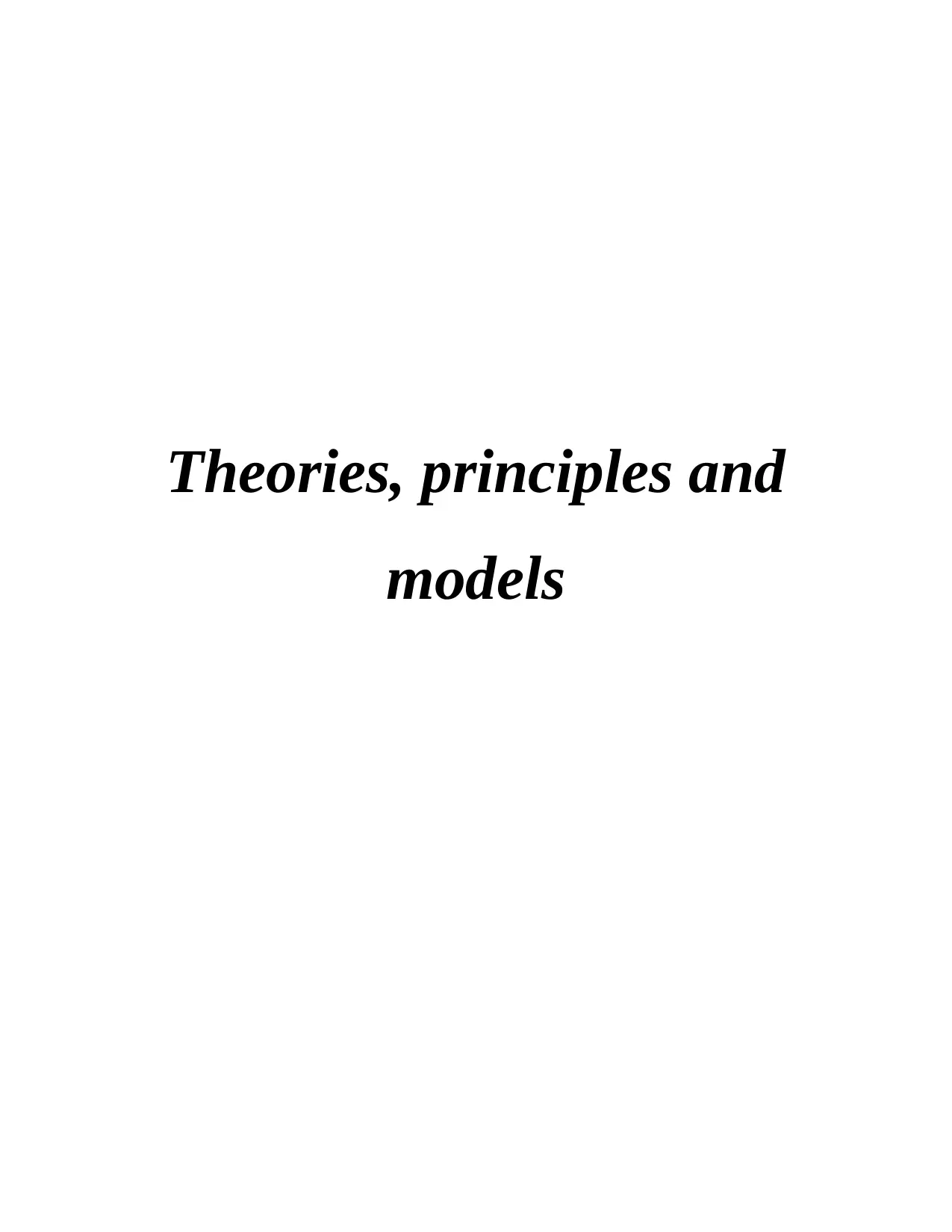
Theories, principles and
models
models
Paraphrase This Document
Need a fresh take? Get an instant paraphrase of this document with our AI Paraphraser
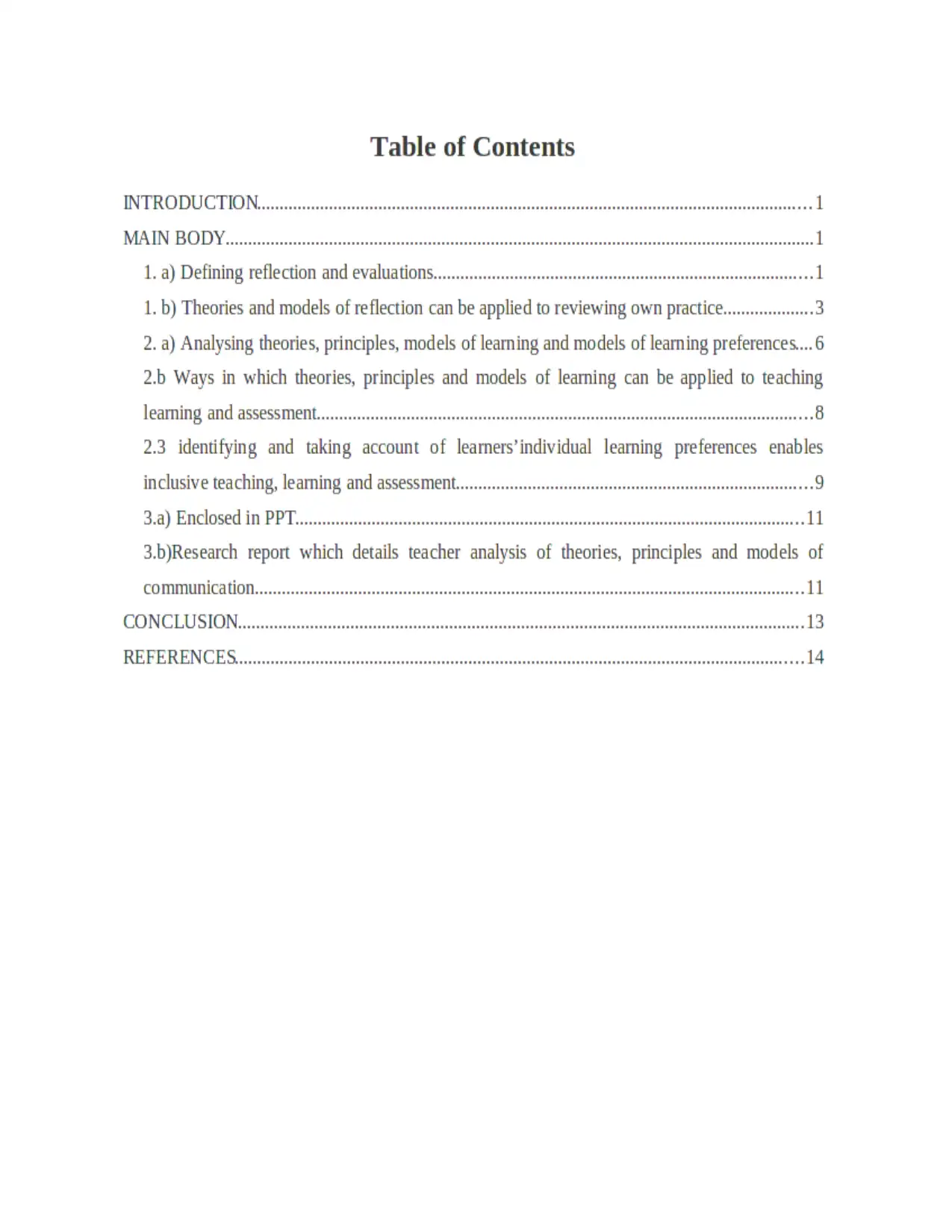
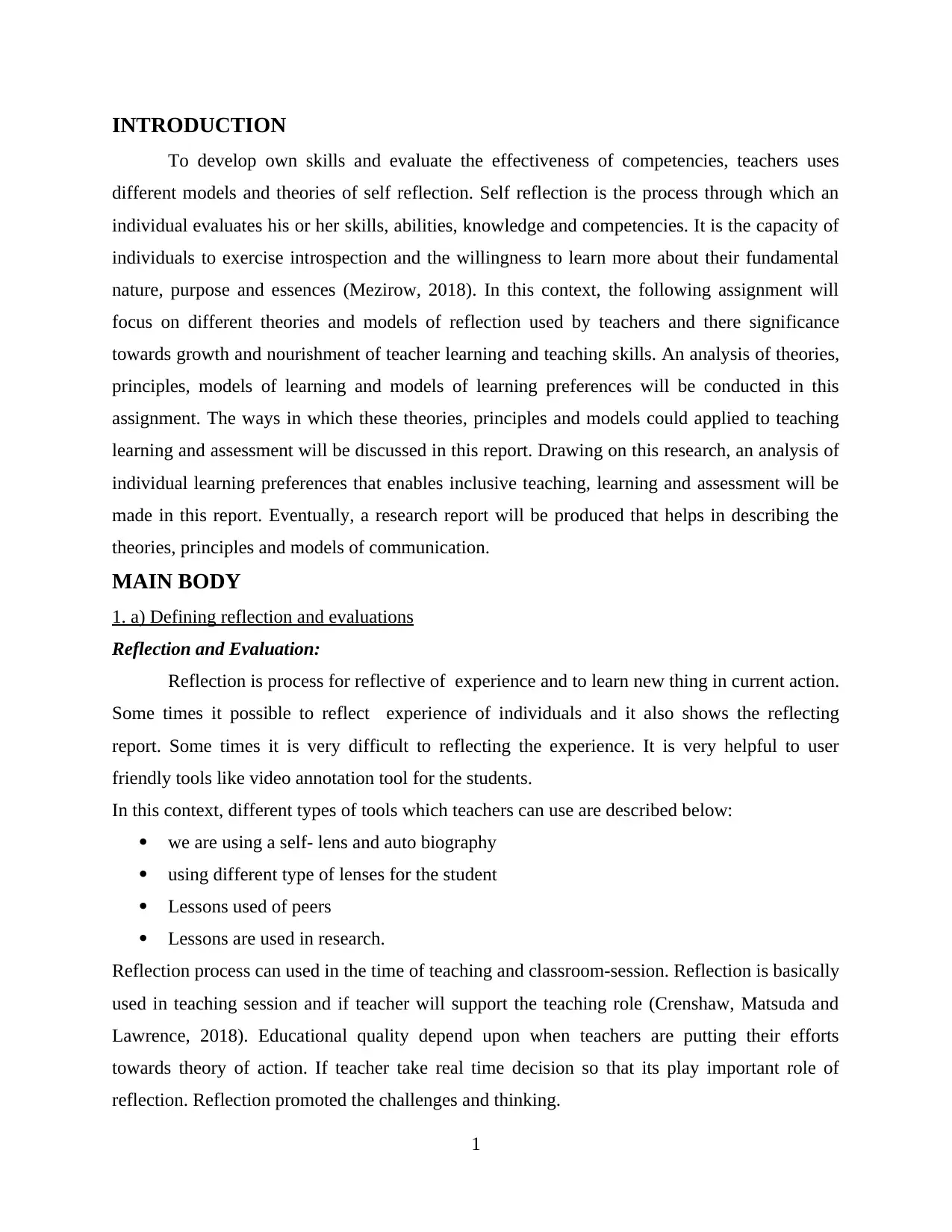
INTRODUCTION
To develop own skills and evaluate the effectiveness of competencies, teachers uses
different models and theories of self reflection. Self reflection is the process through which an
individual evaluates his or her skills, abilities, knowledge and competencies. It is the capacity of
individuals to exercise introspection and the willingness to learn more about their fundamental
nature, purpose and essences (Mezirow, 2018). In this context, the following assignment will
focus on different theories and models of reflection used by teachers and there significance
towards growth and nourishment of teacher learning and teaching skills. An analysis of theories,
principles, models of learning and models of learning preferences will be conducted in this
assignment. The ways in which these theories, principles and models could applied to teaching
learning and assessment will be discussed in this report. Drawing on this research, an analysis of
individual learning preferences that enables inclusive teaching, learning and assessment will be
made in this report. Eventually, a research report will be produced that helps in describing the
theories, principles and models of communication.
MAIN BODY
1. a) Defining reflection and evaluations
Reflection and Evaluation:
Reflection is process for reflective of experience and to learn new thing in current action.
Some times it possible to reflect experience of individuals and it also shows the reflecting
report. Some times it is very difficult to reflecting the experience. It is very helpful to user
friendly tools like video annotation tool for the students.
In this context, different types of tools which teachers can use are described below:
we are using a self- lens and auto biography
using different type of lenses for the student
Lessons used of peers
Lessons are used in research.
Reflection process can used in the time of teaching and classroom-session. Reflection is basically
used in teaching session and if teacher will support the teaching role (Crenshaw, Matsuda and
Lawrence, 2018). Educational quality depend upon when teachers are putting their efforts
towards theory of action. If teacher take real time decision so that its play important role of
reflection. Reflection promoted the challenges and thinking.
1
To develop own skills and evaluate the effectiveness of competencies, teachers uses
different models and theories of self reflection. Self reflection is the process through which an
individual evaluates his or her skills, abilities, knowledge and competencies. It is the capacity of
individuals to exercise introspection and the willingness to learn more about their fundamental
nature, purpose and essences (Mezirow, 2018). In this context, the following assignment will
focus on different theories and models of reflection used by teachers and there significance
towards growth and nourishment of teacher learning and teaching skills. An analysis of theories,
principles, models of learning and models of learning preferences will be conducted in this
assignment. The ways in which these theories, principles and models could applied to teaching
learning and assessment will be discussed in this report. Drawing on this research, an analysis of
individual learning preferences that enables inclusive teaching, learning and assessment will be
made in this report. Eventually, a research report will be produced that helps in describing the
theories, principles and models of communication.
MAIN BODY
1. a) Defining reflection and evaluations
Reflection and Evaluation:
Reflection is process for reflective of experience and to learn new thing in current action.
Some times it possible to reflect experience of individuals and it also shows the reflecting
report. Some times it is very difficult to reflecting the experience. It is very helpful to user
friendly tools like video annotation tool for the students.
In this context, different types of tools which teachers can use are described below:
we are using a self- lens and auto biography
using different type of lenses for the student
Lessons used of peers
Lessons are used in research.
Reflection process can used in the time of teaching and classroom-session. Reflection is basically
used in teaching session and if teacher will support the teaching role (Crenshaw, Matsuda and
Lawrence, 2018). Educational quality depend upon when teachers are putting their efforts
towards theory of action. If teacher take real time decision so that its play important role of
reflection. Reflection promoted the challenges and thinking.
1
⊘ This is a preview!⊘
Do you want full access?
Subscribe today to unlock all pages.

Trusted by 1+ million students worldwide
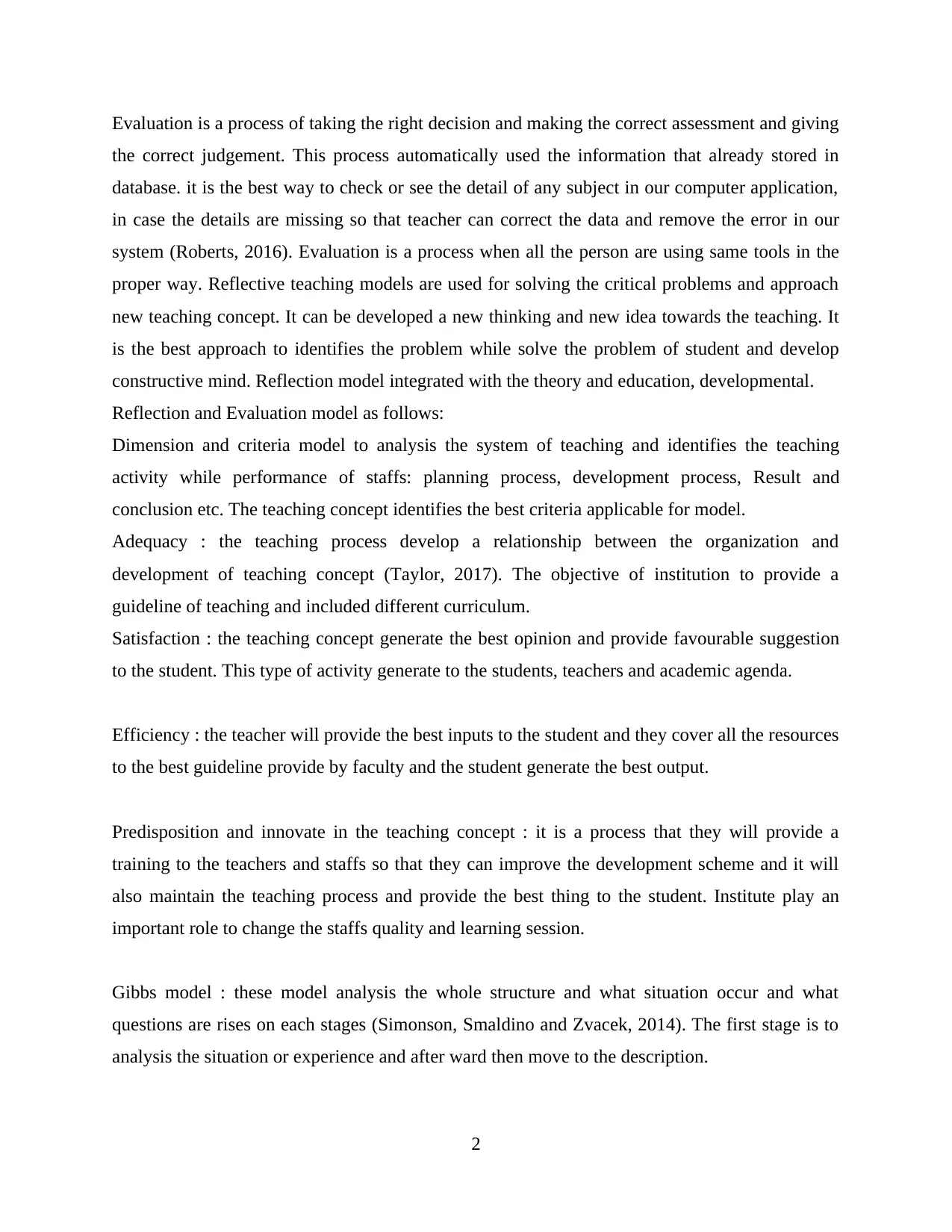
Evaluation is a process of taking the right decision and making the correct assessment and giving
the correct judgement. This process automatically used the information that already stored in
database. it is the best way to check or see the detail of any subject in our computer application,
in case the details are missing so that teacher can correct the data and remove the error in our
system (Roberts, 2016). Evaluation is a process when all the person are using same tools in the
proper way. Reflective teaching models are used for solving the critical problems and approach
new teaching concept. It can be developed a new thinking and new idea towards the teaching. It
is the best approach to identifies the problem while solve the problem of student and develop
constructive mind. Reflection model integrated with the theory and education, developmental.
Reflection and Evaluation model as follows:
Dimension and criteria model to analysis the system of teaching and identifies the teaching
activity while performance of staffs: planning process, development process, Result and
conclusion etc. The teaching concept identifies the best criteria applicable for model.
Adequacy : the teaching process develop a relationship between the organization and
development of teaching concept (Taylor, 2017). The objective of institution to provide a
guideline of teaching and included different curriculum.
Satisfaction : the teaching concept generate the best opinion and provide favourable suggestion
to the student. This type of activity generate to the students, teachers and academic agenda.
Efficiency : the teacher will provide the best inputs to the student and they cover all the resources
to the best guideline provide by faculty and the student generate the best output.
Predisposition and innovate in the teaching concept : it is a process that they will provide a
training to the teachers and staffs so that they can improve the development scheme and it will
also maintain the teaching process and provide the best thing to the student. Institute play an
important role to change the staffs quality and learning session.
Gibbs model : these model analysis the whole structure and what situation occur and what
questions are rises on each stages (Simonson, Smaldino and Zvacek, 2014). The first stage is to
analysis the situation or experience and after ward then move to the description.
2
the correct judgement. This process automatically used the information that already stored in
database. it is the best way to check or see the detail of any subject in our computer application,
in case the details are missing so that teacher can correct the data and remove the error in our
system (Roberts, 2016). Evaluation is a process when all the person are using same tools in the
proper way. Reflective teaching models are used for solving the critical problems and approach
new teaching concept. It can be developed a new thinking and new idea towards the teaching. It
is the best approach to identifies the problem while solve the problem of student and develop
constructive mind. Reflection model integrated with the theory and education, developmental.
Reflection and Evaluation model as follows:
Dimension and criteria model to analysis the system of teaching and identifies the teaching
activity while performance of staffs: planning process, development process, Result and
conclusion etc. The teaching concept identifies the best criteria applicable for model.
Adequacy : the teaching process develop a relationship between the organization and
development of teaching concept (Taylor, 2017). The objective of institution to provide a
guideline of teaching and included different curriculum.
Satisfaction : the teaching concept generate the best opinion and provide favourable suggestion
to the student. This type of activity generate to the students, teachers and academic agenda.
Efficiency : the teacher will provide the best inputs to the student and they cover all the resources
to the best guideline provide by faculty and the student generate the best output.
Predisposition and innovate in the teaching concept : it is a process that they will provide a
training to the teachers and staffs so that they can improve the development scheme and it will
also maintain the teaching process and provide the best thing to the student. Institute play an
important role to change the staffs quality and learning session.
Gibbs model : these model analysis the whole structure and what situation occur and what
questions are rises on each stages (Simonson, Smaldino and Zvacek, 2014). The first stage is to
analysis the situation or experience and after ward then move to the description.
2
Paraphrase This Document
Need a fresh take? Get an instant paraphrase of this document with our AI Paraphraser
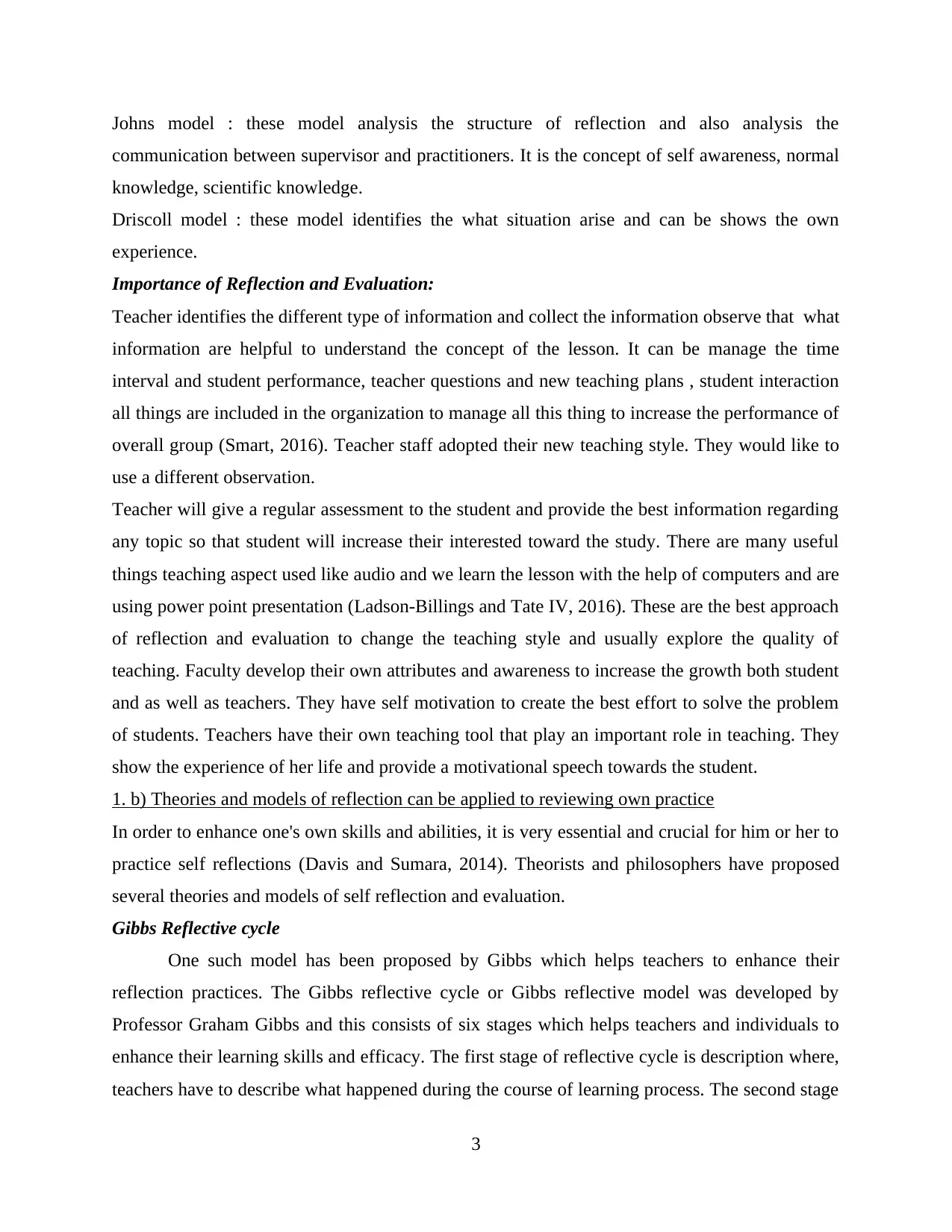
Johns model : these model analysis the structure of reflection and also analysis the
communication between supervisor and practitioners. It is the concept of self awareness, normal
knowledge, scientific knowledge.
Driscoll model : these model identifies the what situation arise and can be shows the own
experience.
Importance of Reflection and Evaluation:
Teacher identifies the different type of information and collect the information observe that what
information are helpful to understand the concept of the lesson. It can be manage the time
interval and student performance, teacher questions and new teaching plans , student interaction
all things are included in the organization to manage all this thing to increase the performance of
overall group (Smart, 2016). Teacher staff adopted their new teaching style. They would like to
use a different observation.
Teacher will give a regular assessment to the student and provide the best information regarding
any topic so that student will increase their interested toward the study. There are many useful
things teaching aspect used like audio and we learn the lesson with the help of computers and are
using power point presentation (Ladson-Billings and Tate IV, 2016). These are the best approach
of reflection and evaluation to change the teaching style and usually explore the quality of
teaching. Faculty develop their own attributes and awareness to increase the growth both student
and as well as teachers. They have self motivation to create the best effort to solve the problem
of students. Teachers have their own teaching tool that play an important role in teaching. They
show the experience of her life and provide a motivational speech towards the student.
1. b) Theories and models of reflection can be applied to reviewing own practice
In order to enhance one's own skills and abilities, it is very essential and crucial for him or her to
practice self reflections (Davis and Sumara, 2014). Theorists and philosophers have proposed
several theories and models of self reflection and evaluation.
Gibbs Reflective cycle
One such model has been proposed by Gibbs which helps teachers to enhance their
reflection practices. The Gibbs reflective cycle or Gibbs reflective model was developed by
Professor Graham Gibbs and this consists of six stages which helps teachers and individuals to
enhance their learning skills and efficacy. The first stage of reflective cycle is description where,
teachers have to describe what happened during the course of learning process. The second stage
3
communication between supervisor and practitioners. It is the concept of self awareness, normal
knowledge, scientific knowledge.
Driscoll model : these model identifies the what situation arise and can be shows the own
experience.
Importance of Reflection and Evaluation:
Teacher identifies the different type of information and collect the information observe that what
information are helpful to understand the concept of the lesson. It can be manage the time
interval and student performance, teacher questions and new teaching plans , student interaction
all things are included in the organization to manage all this thing to increase the performance of
overall group (Smart, 2016). Teacher staff adopted their new teaching style. They would like to
use a different observation.
Teacher will give a regular assessment to the student and provide the best information regarding
any topic so that student will increase their interested toward the study. There are many useful
things teaching aspect used like audio and we learn the lesson with the help of computers and are
using power point presentation (Ladson-Billings and Tate IV, 2016). These are the best approach
of reflection and evaluation to change the teaching style and usually explore the quality of
teaching. Faculty develop their own attributes and awareness to increase the growth both student
and as well as teachers. They have self motivation to create the best effort to solve the problem
of students. Teachers have their own teaching tool that play an important role in teaching. They
show the experience of her life and provide a motivational speech towards the student.
1. b) Theories and models of reflection can be applied to reviewing own practice
In order to enhance one's own skills and abilities, it is very essential and crucial for him or her to
practice self reflections (Davis and Sumara, 2014). Theorists and philosophers have proposed
several theories and models of self reflection and evaluation.
Gibbs Reflective cycle
One such model has been proposed by Gibbs which helps teachers to enhance their
reflection practices. The Gibbs reflective cycle or Gibbs reflective model was developed by
Professor Graham Gibbs and this consists of six stages which helps teachers and individuals to
enhance their learning skills and efficacy. The first stage of reflective cycle is description where,
teachers have to describe what happened during the course of learning process. The second stage
3
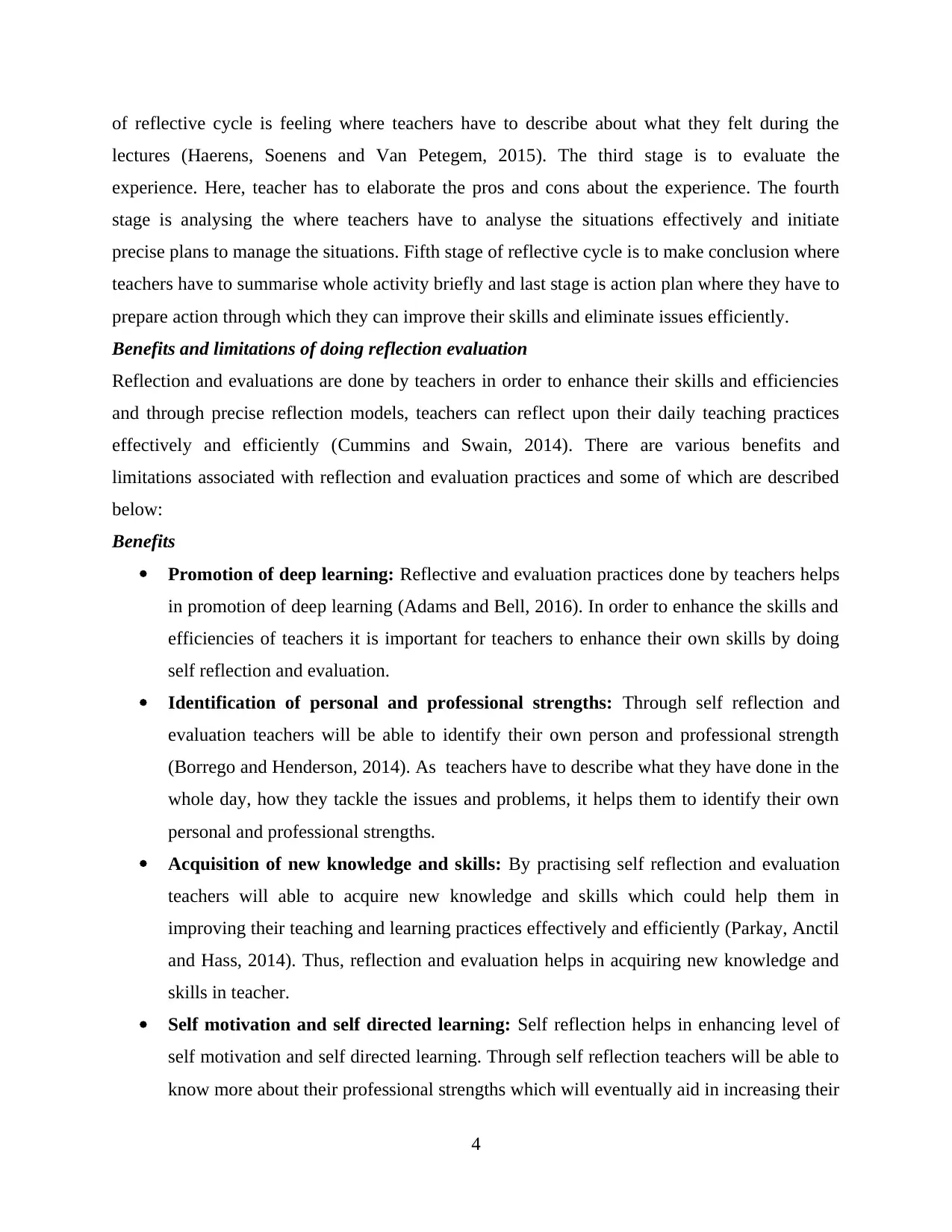
of reflective cycle is feeling where teachers have to describe about what they felt during the
lectures (Haerens, Soenens and Van Petegem, 2015). The third stage is to evaluate the
experience. Here, teacher has to elaborate the pros and cons about the experience. The fourth
stage is analysing the where teachers have to analyse the situations effectively and initiate
precise plans to manage the situations. Fifth stage of reflective cycle is to make conclusion where
teachers have to summarise whole activity briefly and last stage is action plan where they have to
prepare action through which they can improve their skills and eliminate issues efficiently.
Benefits and limitations of doing reflection evaluation
Reflection and evaluations are done by teachers in order to enhance their skills and efficiencies
and through precise reflection models, teachers can reflect upon their daily teaching practices
effectively and efficiently (Cummins and Swain, 2014). There are various benefits and
limitations associated with reflection and evaluation practices and some of which are described
below:
Benefits
Promotion of deep learning: Reflective and evaluation practices done by teachers helps
in promotion of deep learning (Adams and Bell, 2016). In order to enhance the skills and
efficiencies of teachers it is important for teachers to enhance their own skills by doing
self reflection and evaluation.
Identification of personal and professional strengths: Through self reflection and
evaluation teachers will be able to identify their own person and professional strength
(Borrego and Henderson, 2014). As teachers have to describe what they have done in the
whole day, how they tackle the issues and problems, it helps them to identify their own
personal and professional strengths.
Acquisition of new knowledge and skills: By practising self reflection and evaluation
teachers will able to acquire new knowledge and skills which could help them in
improving their teaching and learning practices effectively and efficiently (Parkay, Anctil
and Hass, 2014). Thus, reflection and evaluation helps in acquiring new knowledge and
skills in teacher.
Self motivation and self directed learning: Self reflection helps in enhancing level of
self motivation and self directed learning. Through self reflection teachers will be able to
know more about their professional strengths which will eventually aid in increasing their
4
lectures (Haerens, Soenens and Van Petegem, 2015). The third stage is to evaluate the
experience. Here, teacher has to elaborate the pros and cons about the experience. The fourth
stage is analysing the where teachers have to analyse the situations effectively and initiate
precise plans to manage the situations. Fifth stage of reflective cycle is to make conclusion where
teachers have to summarise whole activity briefly and last stage is action plan where they have to
prepare action through which they can improve their skills and eliminate issues efficiently.
Benefits and limitations of doing reflection evaluation
Reflection and evaluations are done by teachers in order to enhance their skills and efficiencies
and through precise reflection models, teachers can reflect upon their daily teaching practices
effectively and efficiently (Cummins and Swain, 2014). There are various benefits and
limitations associated with reflection and evaluation practices and some of which are described
below:
Benefits
Promotion of deep learning: Reflective and evaluation practices done by teachers helps
in promotion of deep learning (Adams and Bell, 2016). In order to enhance the skills and
efficiencies of teachers it is important for teachers to enhance their own skills by doing
self reflection and evaluation.
Identification of personal and professional strengths: Through self reflection and
evaluation teachers will be able to identify their own person and professional strength
(Borrego and Henderson, 2014). As teachers have to describe what they have done in the
whole day, how they tackle the issues and problems, it helps them to identify their own
personal and professional strengths.
Acquisition of new knowledge and skills: By practising self reflection and evaluation
teachers will able to acquire new knowledge and skills which could help them in
improving their teaching and learning practices effectively and efficiently (Parkay, Anctil
and Hass, 2014). Thus, reflection and evaluation helps in acquiring new knowledge and
skills in teacher.
Self motivation and self directed learning: Self reflection helps in enhancing level of
self motivation and self directed learning. Through self reflection teachers will be able to
know more about their professional strengths which will eventually aid in increasing their
4
⊘ This is a preview!⊘
Do you want full access?
Subscribe today to unlock all pages.

Trusted by 1+ million students worldwide
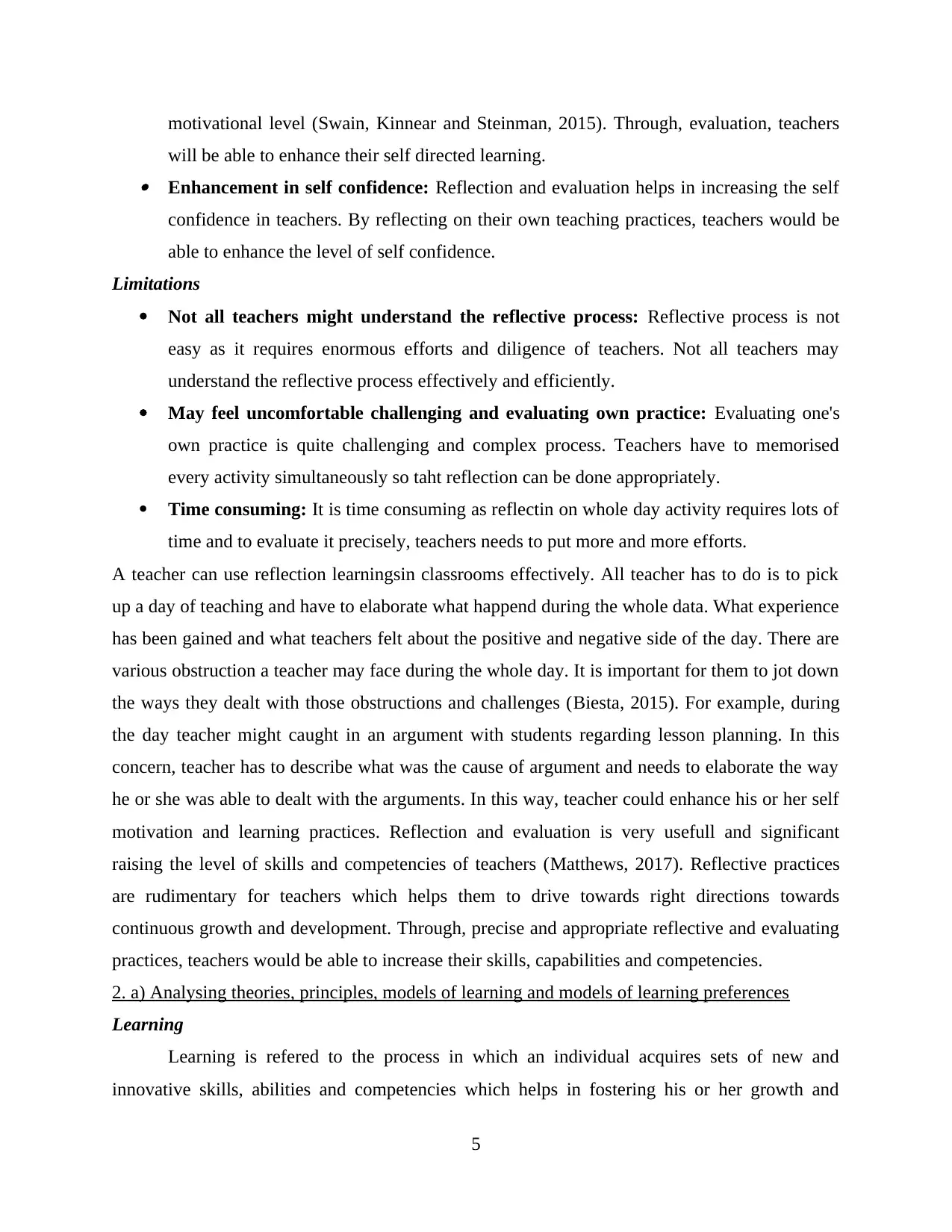
motivational level (Swain, Kinnear and Steinman, 2015). Through, evaluation, teachers
will be able to enhance their self directed learning. Enhancement in self confidence: Reflection and evaluation helps in increasing the self
confidence in teachers. By reflecting on their own teaching practices, teachers would be
able to enhance the level of self confidence.
Limitations
Not all teachers might understand the reflective process: Reflective process is not
easy as it requires enormous efforts and diligence of teachers. Not all teachers may
understand the reflective process effectively and efficiently.
May feel uncomfortable challenging and evaluating own practice: Evaluating one's
own practice is quite challenging and complex process. Teachers have to memorised
every activity simultaneously so taht reflection can be done appropriately.
Time consuming: It is time consuming as reflectin on whole day activity requires lots of
time and to evaluate it precisely, teachers needs to put more and more efforts.
A teacher can use reflection learningsin classrooms effectively. All teacher has to do is to pick
up a day of teaching and have to elaborate what happend during the whole data. What experience
has been gained and what teachers felt about the positive and negative side of the day. There are
various obstruction a teacher may face during the whole day. It is important for them to jot down
the ways they dealt with those obstructions and challenges (Biesta, 2015). For example, during
the day teacher might caught in an argument with students regarding lesson planning. In this
concern, teacher has to describe what was the cause of argument and needs to elaborate the way
he or she was able to dealt with the arguments. In this way, teacher could enhance his or her self
motivation and learning practices. Reflection and evaluation is very usefull and significant
raising the level of skills and competencies of teachers (Matthews, 2017). Reflective practices
are rudimentary for teachers which helps them to drive towards right directions towards
continuous growth and development. Through, precise and appropriate reflective and evaluating
practices, teachers would be able to increase their skills, capabilities and competencies.
2. a) Analysing theories, principles, models of learning and models of learning preferences
Learning
Learning is refered to the process in which an individual acquires sets of new and
innovative skills, abilities and competencies which helps in fostering his or her growth and
5
will be able to enhance their self directed learning. Enhancement in self confidence: Reflection and evaluation helps in increasing the self
confidence in teachers. By reflecting on their own teaching practices, teachers would be
able to enhance the level of self confidence.
Limitations
Not all teachers might understand the reflective process: Reflective process is not
easy as it requires enormous efforts and diligence of teachers. Not all teachers may
understand the reflective process effectively and efficiently.
May feel uncomfortable challenging and evaluating own practice: Evaluating one's
own practice is quite challenging and complex process. Teachers have to memorised
every activity simultaneously so taht reflection can be done appropriately.
Time consuming: It is time consuming as reflectin on whole day activity requires lots of
time and to evaluate it precisely, teachers needs to put more and more efforts.
A teacher can use reflection learningsin classrooms effectively. All teacher has to do is to pick
up a day of teaching and have to elaborate what happend during the whole data. What experience
has been gained and what teachers felt about the positive and negative side of the day. There are
various obstruction a teacher may face during the whole day. It is important for them to jot down
the ways they dealt with those obstructions and challenges (Biesta, 2015). For example, during
the day teacher might caught in an argument with students regarding lesson planning. In this
concern, teacher has to describe what was the cause of argument and needs to elaborate the way
he or she was able to dealt with the arguments. In this way, teacher could enhance his or her self
motivation and learning practices. Reflection and evaluation is very usefull and significant
raising the level of skills and competencies of teachers (Matthews, 2017). Reflective practices
are rudimentary for teachers which helps them to drive towards right directions towards
continuous growth and development. Through, precise and appropriate reflective and evaluating
practices, teachers would be able to increase their skills, capabilities and competencies.
2. a) Analysing theories, principles, models of learning and models of learning preferences
Learning
Learning is refered to the process in which an individual acquires sets of new and
innovative skills, abilities and competencies which helps in fostering his or her growth and
5
Paraphrase This Document
Need a fresh take? Get an instant paraphrase of this document with our AI Paraphraser
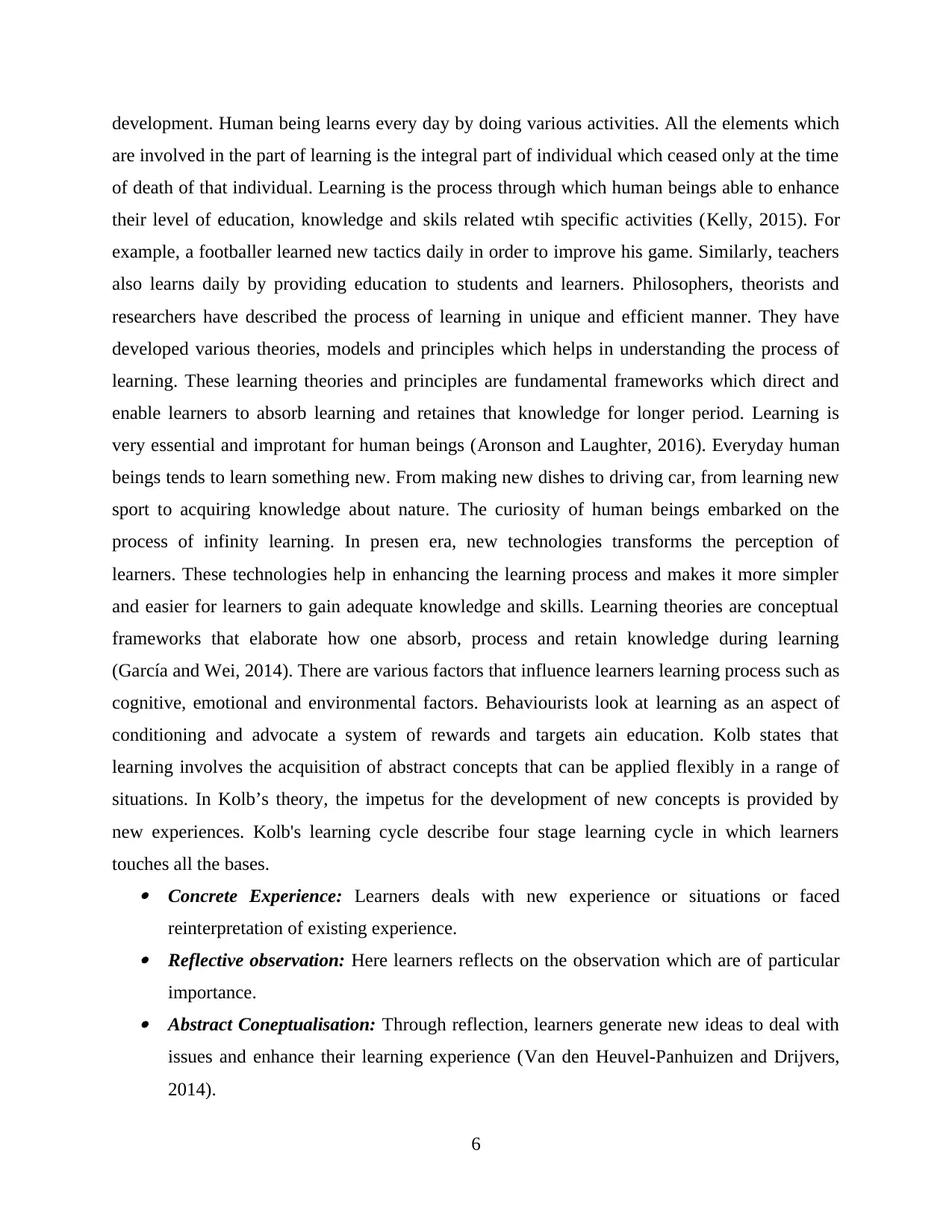
development. Human being learns every day by doing various activities. All the elements which
are involved in the part of learning is the integral part of individual which ceased only at the time
of death of that individual. Learning is the process through which human beings able to enhance
their level of education, knowledge and skils related wtih specific activities (Kelly, 2015). For
example, a footballer learned new tactics daily in order to improve his game. Similarly, teachers
also learns daily by providing education to students and learners. Philosophers, theorists and
researchers have described the process of learning in unique and efficient manner. They have
developed various theories, models and principles which helps in understanding the process of
learning. These learning theories and principles are fundamental frameworks which direct and
enable learners to absorb learning and retaines that knowledge for longer period. Learning is
very essential and improtant for human beings (Aronson and Laughter, 2016). Everyday human
beings tends to learn something new. From making new dishes to driving car, from learning new
sport to acquiring knowledge about nature. The curiosity of human beings embarked on the
process of infinity learning. In presen era, new technologies transforms the perception of
learners. These technologies help in enhancing the learning process and makes it more simpler
and easier for learners to gain adequate knowledge and skills. Learning theories are conceptual
frameworks that elaborate how one absorb, process and retain knowledge during learning
(García and Wei, 2014). There are various factors that influence learners learning process such as
cognitive, emotional and environmental factors. Behaviourists look at learning as an aspect of
conditioning and advocate a system of rewards and targets ain education. Kolb states that
learning involves the acquisition of abstract concepts that can be applied flexibly in a range of
situations. In Kolb’s theory, the impetus for the development of new concepts is provided by
new experiences. Kolb's learning cycle describe four stage learning cycle in which learners
touches all the bases. Concrete Experience: Learners deals with new experience or situations or faced
reinterpretation of existing experience. Reflective observation: Here learners reflects on the observation which are of particular
importance. Abstract Coneptualisation: Through reflection, learners generate new ideas to deal with
issues and enhance their learning experience (Van den Heuvel-Panhuizen and Drijvers,
2014).
6
are involved in the part of learning is the integral part of individual which ceased only at the time
of death of that individual. Learning is the process through which human beings able to enhance
their level of education, knowledge and skils related wtih specific activities (Kelly, 2015). For
example, a footballer learned new tactics daily in order to improve his game. Similarly, teachers
also learns daily by providing education to students and learners. Philosophers, theorists and
researchers have described the process of learning in unique and efficient manner. They have
developed various theories, models and principles which helps in understanding the process of
learning. These learning theories and principles are fundamental frameworks which direct and
enable learners to absorb learning and retaines that knowledge for longer period. Learning is
very essential and improtant for human beings (Aronson and Laughter, 2016). Everyday human
beings tends to learn something new. From making new dishes to driving car, from learning new
sport to acquiring knowledge about nature. The curiosity of human beings embarked on the
process of infinity learning. In presen era, new technologies transforms the perception of
learners. These technologies help in enhancing the learning process and makes it more simpler
and easier for learners to gain adequate knowledge and skills. Learning theories are conceptual
frameworks that elaborate how one absorb, process and retain knowledge during learning
(García and Wei, 2014). There are various factors that influence learners learning process such as
cognitive, emotional and environmental factors. Behaviourists look at learning as an aspect of
conditioning and advocate a system of rewards and targets ain education. Kolb states that
learning involves the acquisition of abstract concepts that can be applied flexibly in a range of
situations. In Kolb’s theory, the impetus for the development of new concepts is provided by
new experiences. Kolb's learning cycle describe four stage learning cycle in which learners
touches all the bases. Concrete Experience: Learners deals with new experience or situations or faced
reinterpretation of existing experience. Reflective observation: Here learners reflects on the observation which are of particular
importance. Abstract Coneptualisation: Through reflection, learners generate new ideas to deal with
issues and enhance their learning experience (Van den Heuvel-Panhuizen and Drijvers,
2014).
6
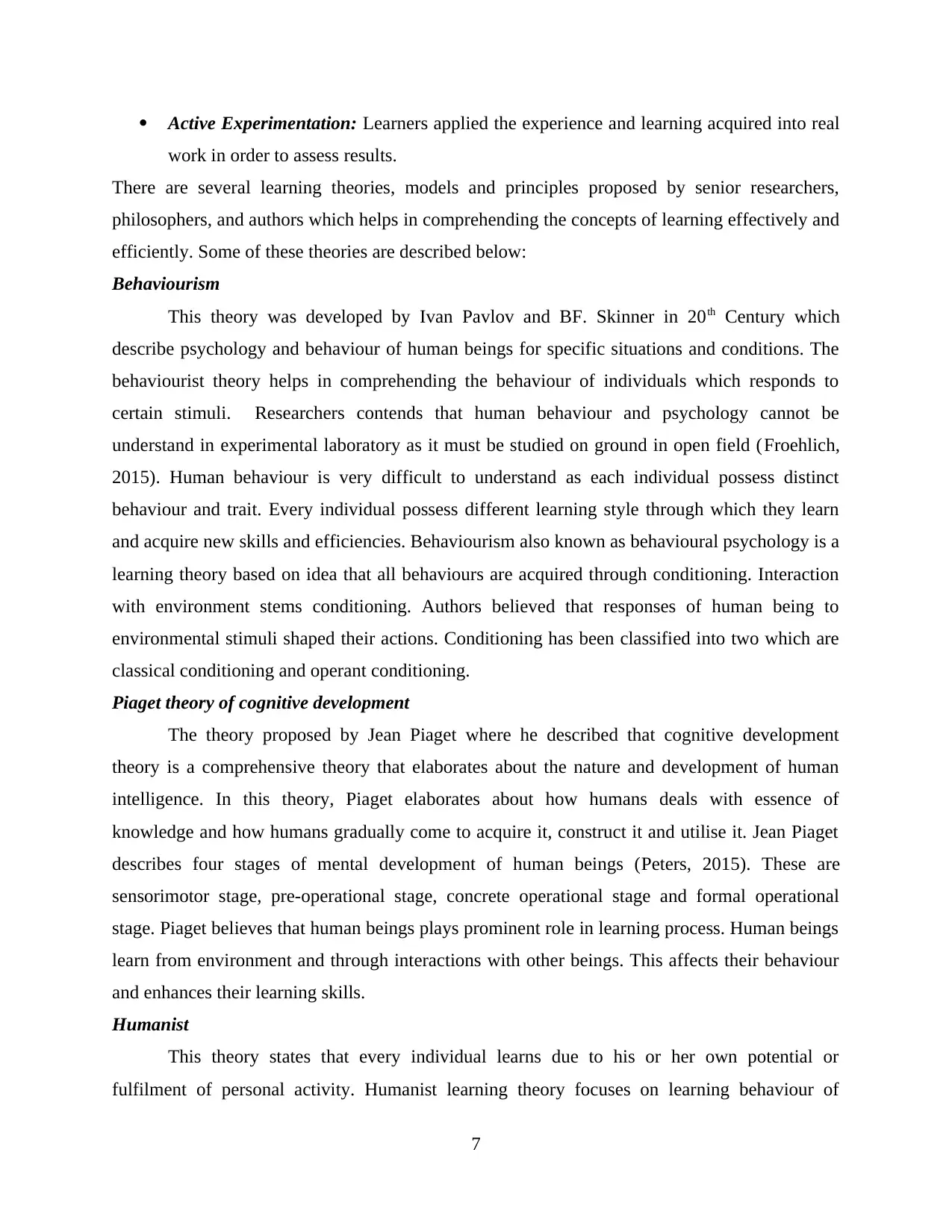
Active Experimentation: Learners applied the experience and learning acquired into real
work in order to assess results.
There are several learning theories, models and principles proposed by senior researchers,
philosophers, and authors which helps in comprehending the concepts of learning effectively and
efficiently. Some of these theories are described below:
Behaviourism
This theory was developed by Ivan Pavlov and BF. Skinner in 20th Century which
describe psychology and behaviour of human beings for specific situations and conditions. The
behaviourist theory helps in comprehending the behaviour of individuals which responds to
certain stimuli. Researchers contends that human behaviour and psychology cannot be
understand in experimental laboratory as it must be studied on ground in open field (Froehlich,
2015). Human behaviour is very difficult to understand as each individual possess distinct
behaviour and trait. Every individual possess different learning style through which they learn
and acquire new skills and efficiencies. Behaviourism also known as behavioural psychology is a
learning theory based on idea that all behaviours are acquired through conditioning. Interaction
with environment stems conditioning. Authors believed that responses of human being to
environmental stimuli shaped their actions. Conditioning has been classified into two which are
classical conditioning and operant conditioning.
Piaget theory of cognitive development
The theory proposed by Jean Piaget where he described that cognitive development
theory is a comprehensive theory that elaborates about the nature and development of human
intelligence. In this theory, Piaget elaborates about how humans deals with essence of
knowledge and how humans gradually come to acquire it, construct it and utilise it. Jean Piaget
describes four stages of mental development of human beings (Peters, 2015). These are
sensorimotor stage, pre-operational stage, concrete operational stage and formal operational
stage. Piaget believes that human beings plays prominent role in learning process. Human beings
learn from environment and through interactions with other beings. This affects their behaviour
and enhances their learning skills.
Humanist
This theory states that every individual learns due to his or her own potential or
fulfilment of personal activity. Humanist learning theory focuses on learning behaviour of
7
work in order to assess results.
There are several learning theories, models and principles proposed by senior researchers,
philosophers, and authors which helps in comprehending the concepts of learning effectively and
efficiently. Some of these theories are described below:
Behaviourism
This theory was developed by Ivan Pavlov and BF. Skinner in 20th Century which
describe psychology and behaviour of human beings for specific situations and conditions. The
behaviourist theory helps in comprehending the behaviour of individuals which responds to
certain stimuli. Researchers contends that human behaviour and psychology cannot be
understand in experimental laboratory as it must be studied on ground in open field (Froehlich,
2015). Human behaviour is very difficult to understand as each individual possess distinct
behaviour and trait. Every individual possess different learning style through which they learn
and acquire new skills and efficiencies. Behaviourism also known as behavioural psychology is a
learning theory based on idea that all behaviours are acquired through conditioning. Interaction
with environment stems conditioning. Authors believed that responses of human being to
environmental stimuli shaped their actions. Conditioning has been classified into two which are
classical conditioning and operant conditioning.
Piaget theory of cognitive development
The theory proposed by Jean Piaget where he described that cognitive development
theory is a comprehensive theory that elaborates about the nature and development of human
intelligence. In this theory, Piaget elaborates about how humans deals with essence of
knowledge and how humans gradually come to acquire it, construct it and utilise it. Jean Piaget
describes four stages of mental development of human beings (Peters, 2015). These are
sensorimotor stage, pre-operational stage, concrete operational stage and formal operational
stage. Piaget believes that human beings plays prominent role in learning process. Human beings
learn from environment and through interactions with other beings. This affects their behaviour
and enhances their learning skills.
Humanist
This theory states that every individual learns due to his or her own potential or
fulfilment of personal activity. Humanist learning theory focuses on learning behaviour of
7
⊘ This is a preview!⊘
Do you want full access?
Subscribe today to unlock all pages.

Trusted by 1+ million students worldwide
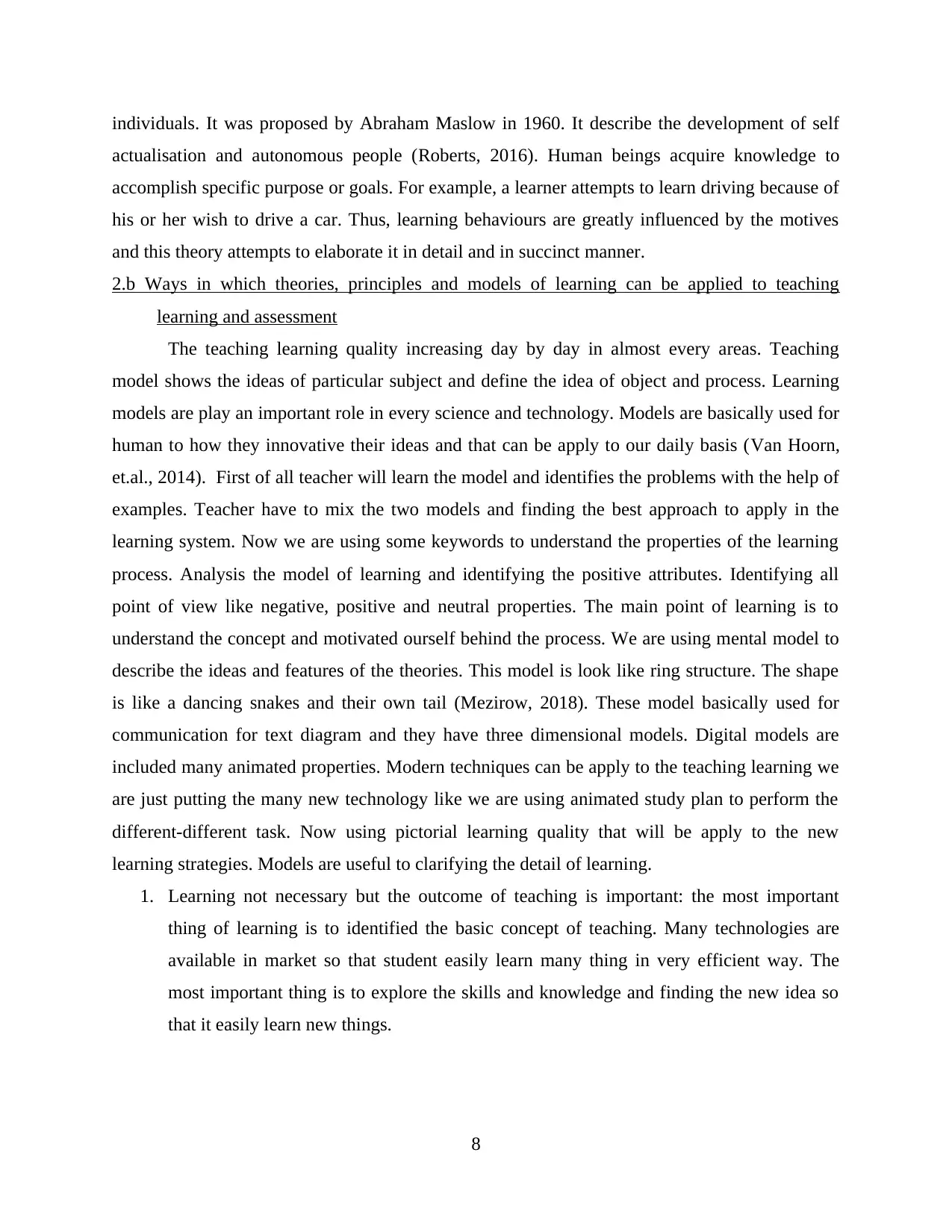
individuals. It was proposed by Abraham Maslow in 1960. It describe the development of self
actualisation and autonomous people (Roberts, 2016). Human beings acquire knowledge to
accomplish specific purpose or goals. For example, a learner attempts to learn driving because of
his or her wish to drive a car. Thus, learning behaviours are greatly influenced by the motives
and this theory attempts to elaborate it in detail and in succinct manner.
2.b Ways in which theories, principles and models of learning can be applied to teaching
learning and assessment
The teaching learning quality increasing day by day in almost every areas. Teaching
model shows the ideas of particular subject and define the idea of object and process. Learning
models are play an important role in every science and technology. Models are basically used for
human to how they innovative their ideas and that can be apply to our daily basis (Van Hoorn,
et.al., 2014). First of all teacher will learn the model and identifies the problems with the help of
examples. Teacher have to mix the two models and finding the best approach to apply in the
learning system. Now we are using some keywords to understand the properties of the learning
process. Analysis the model of learning and identifying the positive attributes. Identifying all
point of view like negative, positive and neutral properties. The main point of learning is to
understand the concept and motivated ourself behind the process. We are using mental model to
describe the ideas and features of the theories. This model is look like ring structure. The shape
is like a dancing snakes and their own tail (Mezirow, 2018). These model basically used for
communication for text diagram and they have three dimensional models. Digital models are
included many animated properties. Modern techniques can be apply to the teaching learning we
are just putting the many new technology like we are using animated study plan to perform the
different-different task. Now using pictorial learning quality that will be apply to the new
learning strategies. Models are useful to clarifying the detail of learning.
1. Learning not necessary but the outcome of teaching is important: the most important
thing of learning is to identified the basic concept of teaching. Many technologies are
available in market so that student easily learn many thing in very efficient way. The
most important thing is to explore the skills and knowledge and finding the new idea so
that it easily learn new things.
8
actualisation and autonomous people (Roberts, 2016). Human beings acquire knowledge to
accomplish specific purpose or goals. For example, a learner attempts to learn driving because of
his or her wish to drive a car. Thus, learning behaviours are greatly influenced by the motives
and this theory attempts to elaborate it in detail and in succinct manner.
2.b Ways in which theories, principles and models of learning can be applied to teaching
learning and assessment
The teaching learning quality increasing day by day in almost every areas. Teaching
model shows the ideas of particular subject and define the idea of object and process. Learning
models are play an important role in every science and technology. Models are basically used for
human to how they innovative their ideas and that can be apply to our daily basis (Van Hoorn,
et.al., 2014). First of all teacher will learn the model and identifies the problems with the help of
examples. Teacher have to mix the two models and finding the best approach to apply in the
learning system. Now we are using some keywords to understand the properties of the learning
process. Analysis the model of learning and identifying the positive attributes. Identifying all
point of view like negative, positive and neutral properties. The main point of learning is to
understand the concept and motivated ourself behind the process. We are using mental model to
describe the ideas and features of the theories. This model is look like ring structure. The shape
is like a dancing snakes and their own tail (Mezirow, 2018). These model basically used for
communication for text diagram and they have three dimensional models. Digital models are
included many animated properties. Modern techniques can be apply to the teaching learning we
are just putting the many new technology like we are using animated study plan to perform the
different-different task. Now using pictorial learning quality that will be apply to the new
learning strategies. Models are useful to clarifying the detail of learning.
1. Learning not necessary but the outcome of teaching is important: the most important
thing of learning is to identified the basic concept of teaching. Many technologies are
available in market so that student easily learn many thing in very efficient way. The
most important thing is to explore the skills and knowledge and finding the new idea so
that it easily learn new things.
8
Paraphrase This Document
Need a fresh take? Get an instant paraphrase of this document with our AI Paraphraser
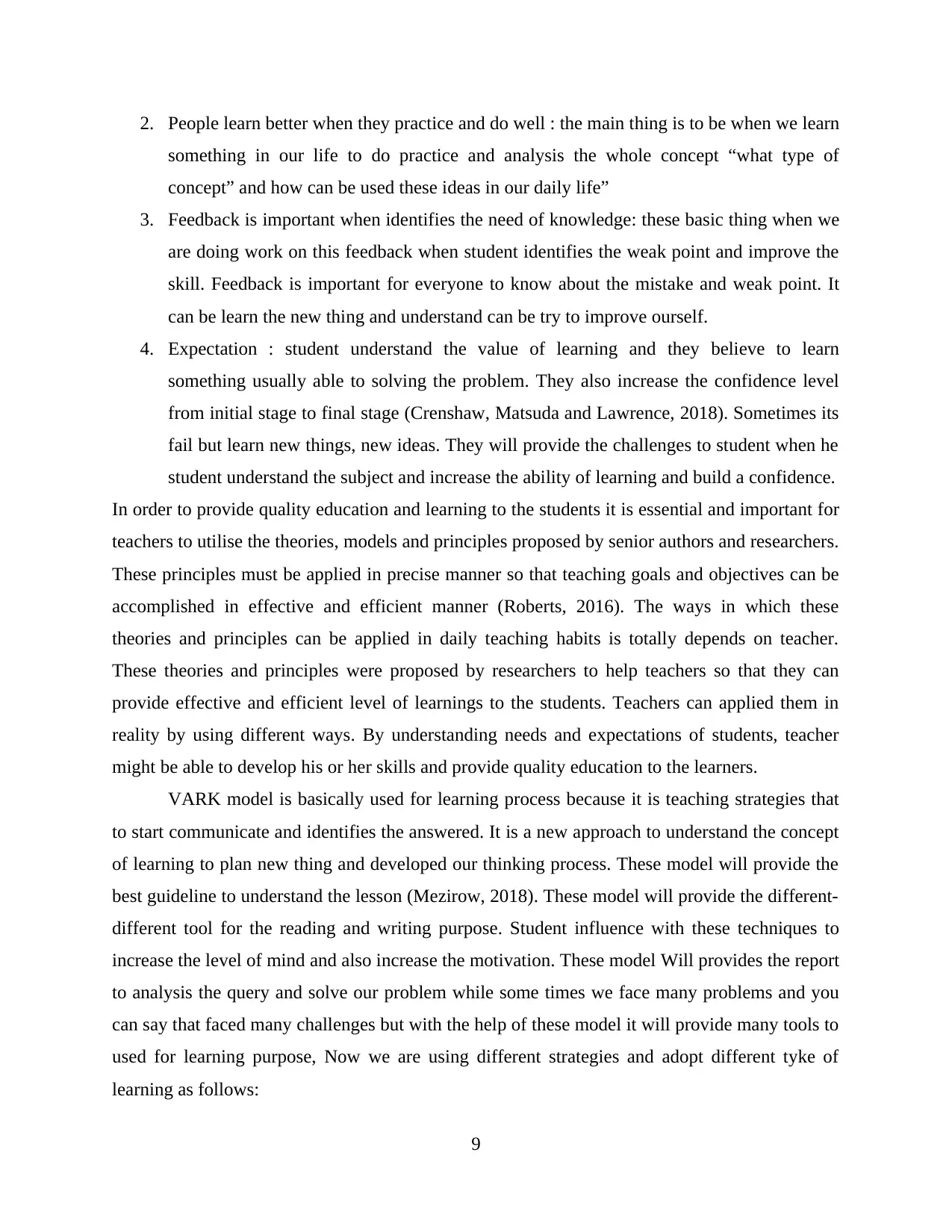
2. People learn better when they practice and do well : the main thing is to be when we learn
something in our life to do practice and analysis the whole concept “what type of
concept” and how can be used these ideas in our daily life”
3. Feedback is important when identifies the need of knowledge: these basic thing when we
are doing work on this feedback when student identifies the weak point and improve the
skill. Feedback is important for everyone to know about the mistake and weak point. It
can be learn the new thing and understand can be try to improve ourself.
4. Expectation : student understand the value of learning and they believe to learn
something usually able to solving the problem. They also increase the confidence level
from initial stage to final stage (Crenshaw, Matsuda and Lawrence, 2018). Sometimes its
fail but learn new things, new ideas. They will provide the challenges to student when he
student understand the subject and increase the ability of learning and build a confidence.
In order to provide quality education and learning to the students it is essential and important for
teachers to utilise the theories, models and principles proposed by senior authors and researchers.
These principles must be applied in precise manner so that teaching goals and objectives can be
accomplished in effective and efficient manner (Roberts, 2016). The ways in which these
theories and principles can be applied in daily teaching habits is totally depends on teacher.
These theories and principles were proposed by researchers to help teachers so that they can
provide effective and efficient level of learnings to the students. Teachers can applied them in
reality by using different ways. By understanding needs and expectations of students, teacher
might be able to develop his or her skills and provide quality education to the learners.
VARK model is basically used for learning process because it is teaching strategies that
to start communicate and identifies the answered. It is a new approach to understand the concept
of learning to plan new thing and developed our thinking process. These model will provide the
best guideline to understand the lesson (Mezirow, 2018). These model will provide the different-
different tool for the reading and writing purpose. Student influence with these techniques to
increase the level of mind and also increase the motivation. These model Will provides the report
to analysis the query and solve our problem while some times we face many problems and you
can say that faced many challenges but with the help of these model it will provide many tools to
used for learning purpose, Now we are using different strategies and adopt different tyke of
learning as follows:
9
something in our life to do practice and analysis the whole concept “what type of
concept” and how can be used these ideas in our daily life”
3. Feedback is important when identifies the need of knowledge: these basic thing when we
are doing work on this feedback when student identifies the weak point and improve the
skill. Feedback is important for everyone to know about the mistake and weak point. It
can be learn the new thing and understand can be try to improve ourself.
4. Expectation : student understand the value of learning and they believe to learn
something usually able to solving the problem. They also increase the confidence level
from initial stage to final stage (Crenshaw, Matsuda and Lawrence, 2018). Sometimes its
fail but learn new things, new ideas. They will provide the challenges to student when he
student understand the subject and increase the ability of learning and build a confidence.
In order to provide quality education and learning to the students it is essential and important for
teachers to utilise the theories, models and principles proposed by senior authors and researchers.
These principles must be applied in precise manner so that teaching goals and objectives can be
accomplished in effective and efficient manner (Roberts, 2016). The ways in which these
theories and principles can be applied in daily teaching habits is totally depends on teacher.
These theories and principles were proposed by researchers to help teachers so that they can
provide effective and efficient level of learnings to the students. Teachers can applied them in
reality by using different ways. By understanding needs and expectations of students, teacher
might be able to develop his or her skills and provide quality education to the learners.
VARK model is basically used for learning process because it is teaching strategies that
to start communicate and identifies the answered. It is a new approach to understand the concept
of learning to plan new thing and developed our thinking process. These model will provide the
best guideline to understand the lesson (Mezirow, 2018). These model will provide the different-
different tool for the reading and writing purpose. Student influence with these techniques to
increase the level of mind and also increase the motivation. These model Will provides the report
to analysis the query and solve our problem while some times we face many problems and you
can say that faced many challenges but with the help of these model it will provide many tools to
used for learning purpose, Now we are using different strategies and adopt different tyke of
learning as follows:
9
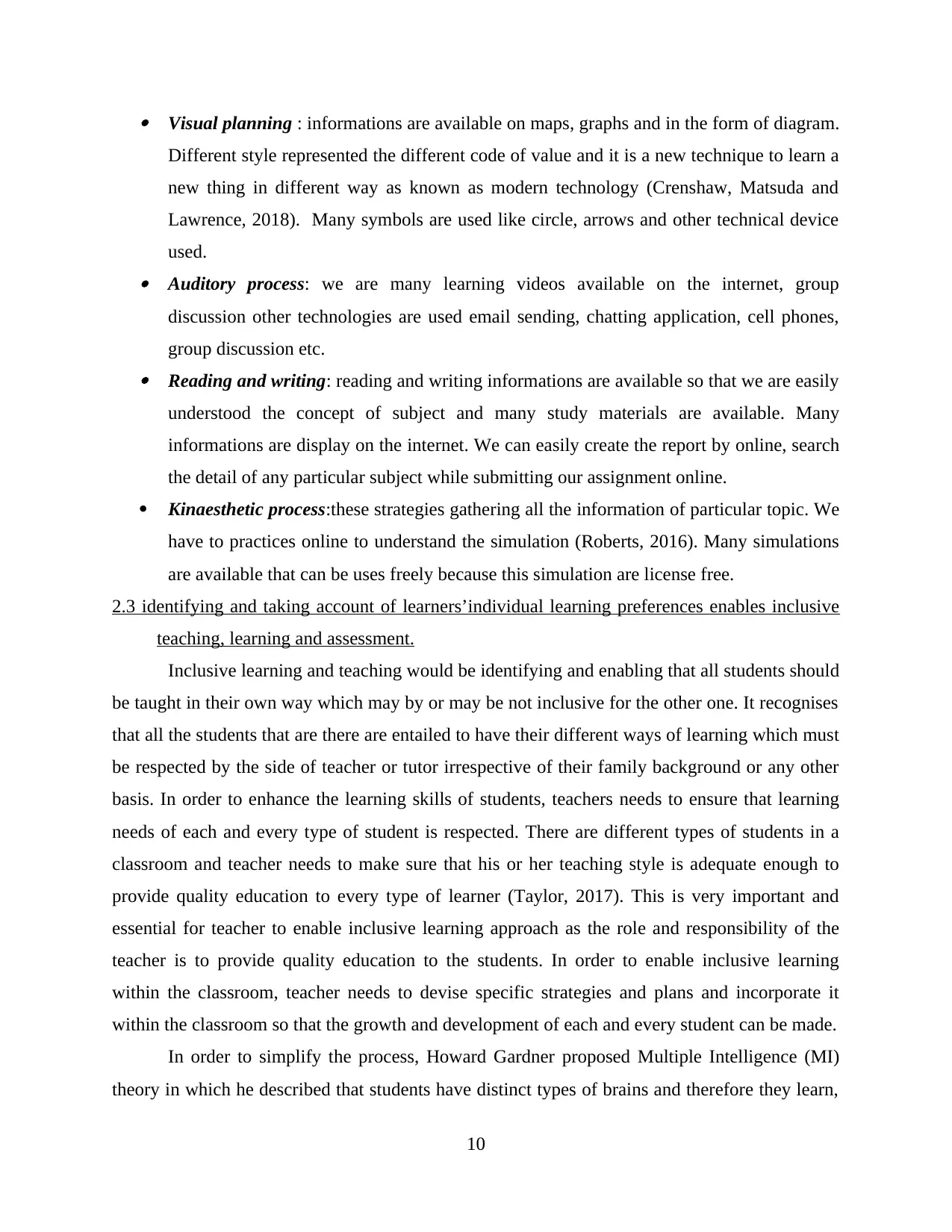
Visual planning : informations are available on maps, graphs and in the form of diagram.
Different style represented the different code of value and it is a new technique to learn a
new thing in different way as known as modern technology (Crenshaw, Matsuda and
Lawrence, 2018). Many symbols are used like circle, arrows and other technical device
used. Auditory process: we are many learning videos available on the internet, group
discussion other technologies are used email sending, chatting application, cell phones,
group discussion etc. Reading and writing: reading and writing informations are available so that we are easily
understood the concept of subject and many study materials are available. Many
informations are display on the internet. We can easily create the report by online, search
the detail of any particular subject while submitting our assignment online.
Kinaesthetic process:these strategies gathering all the information of particular topic. We
have to practices online to understand the simulation (Roberts, 2016). Many simulations
are available that can be uses freely because this simulation are license free.
2.3 identifying and taking account of learners’individual learning preferences enables inclusive
teaching, learning and assessment.
Inclusive learning and teaching would be identifying and enabling that all students should
be taught in their own way which may by or may be not inclusive for the other one. It recognises
that all the students that are there are entailed to have their different ways of learning which must
be respected by the side of teacher or tutor irrespective of their family background or any other
basis. In order to enhance the learning skills of students, teachers needs to ensure that learning
needs of each and every type of student is respected. There are different types of students in a
classroom and teacher needs to make sure that his or her teaching style is adequate enough to
provide quality education to every type of learner (Taylor, 2017). This is very important and
essential for teacher to enable inclusive learning approach as the role and responsibility of the
teacher is to provide quality education to the students. In order to enable inclusive learning
within the classroom, teacher needs to devise specific strategies and plans and incorporate it
within the classroom so that the growth and development of each and every student can be made.
In order to simplify the process, Howard Gardner proposed Multiple Intelligence (MI)
theory in which he described that students have distinct types of brains and therefore they learn,
10
Different style represented the different code of value and it is a new technique to learn a
new thing in different way as known as modern technology (Crenshaw, Matsuda and
Lawrence, 2018). Many symbols are used like circle, arrows and other technical device
used. Auditory process: we are many learning videos available on the internet, group
discussion other technologies are used email sending, chatting application, cell phones,
group discussion etc. Reading and writing: reading and writing informations are available so that we are easily
understood the concept of subject and many study materials are available. Many
informations are display on the internet. We can easily create the report by online, search
the detail of any particular subject while submitting our assignment online.
Kinaesthetic process:these strategies gathering all the information of particular topic. We
have to practices online to understand the simulation (Roberts, 2016). Many simulations
are available that can be uses freely because this simulation are license free.
2.3 identifying and taking account of learners’individual learning preferences enables inclusive
teaching, learning and assessment.
Inclusive learning and teaching would be identifying and enabling that all students should
be taught in their own way which may by or may be not inclusive for the other one. It recognises
that all the students that are there are entailed to have their different ways of learning which must
be respected by the side of teacher or tutor irrespective of their family background or any other
basis. In order to enhance the learning skills of students, teachers needs to ensure that learning
needs of each and every type of student is respected. There are different types of students in a
classroom and teacher needs to make sure that his or her teaching style is adequate enough to
provide quality education to every type of learner (Taylor, 2017). This is very important and
essential for teacher to enable inclusive learning approach as the role and responsibility of the
teacher is to provide quality education to the students. In order to enable inclusive learning
within the classroom, teacher needs to devise specific strategies and plans and incorporate it
within the classroom so that the growth and development of each and every student can be made.
In order to simplify the process, Howard Gardner proposed Multiple Intelligence (MI)
theory in which he described that students have distinct types of brains and therefore they learn,
10
⊘ This is a preview!⊘
Do you want full access?
Subscribe today to unlock all pages.

Trusted by 1+ million students worldwide
1 out of 18
Related Documents
Your All-in-One AI-Powered Toolkit for Academic Success.
+13062052269
info@desklib.com
Available 24*7 on WhatsApp / Email
![[object Object]](/_next/static/media/star-bottom.7253800d.svg)
Unlock your academic potential
Copyright © 2020–2025 A2Z Services. All Rights Reserved. Developed and managed by ZUCOL.



